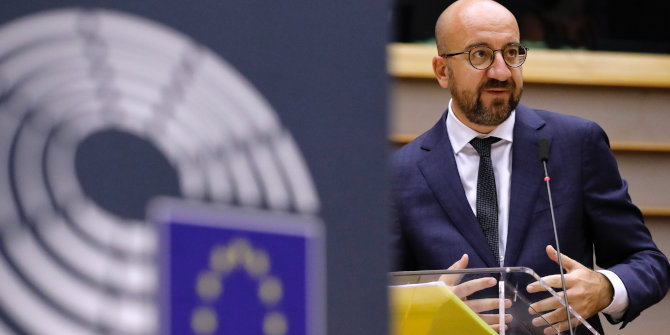
 The Covid-19 crisis has renewed calls for the creation of common bonds for member states of the Eurozone. However, as Zarko Kalamov and Klaas Staal explain, common bonds would have potentially far-reaching implications. They outline some of the existing proposals, identify their weaknesses and propose some possible solutions.
The Covid-19 crisis has renewed calls for the creation of common bonds for member states of the Eurozone. However, as Zarko Kalamov and Klaas Staal explain, common bonds would have potentially far-reaching implications. They outline some of the existing proposals, identify their weaknesses and propose some possible solutions.
Currently, we are in a state of crisis, with sweeping economic consequences. To mitigate these consequences, governments are proposing costly fiscal stimulus measures. Financing these measures is expected to involve additional public borrowing. As the financial positions of European countries vary widely, this borrowing comes at low cost to some, but likely entails prohibitively high costs for other governments.
One of the proposed policy responses is therefore the mutualisation of public debt, in the form of so-called Eurobonds or coronabonds. Because these bonds would be backed by all member states, they should have a high credit rating and low interest costs. Depending on the implementation of common bonds, however, this could imply moral-hazard and redistributive consequences that have far-reaching implications for public support for cooperation in the European Union.
One option for introducing common bonds would be the full substitution of common bonds for national bonds with several and joint guarantees. This means that every country would be fully responsible for the debt of others. The implication is that interest rates for all countries would be equal; whenever a country does not service its debt then all the others would be obliged by the joint guarantees to pay. The amount of a country’s borrowing would no longer affect the rate of interest it has to pay on its debt. This would thus remove the incentive to limit public debt, and hence induce a large moral hazard problem.

Video conference between EU Economic and Finance Ministers on 16 April 2020, Credit: European Union
The same effect emerges if the European Central Bank (ECB) purchases the bonds. It has been argued that “this step would make them [Eurobonds] risk-free”. These bonds are not risk-free, however, as countries may still default. It is also not true that, however implemented, Eurobonds do not have distributional consequences. This is obviously clear when countries, in the case of a default, have to repay the debts of others. It is also the case when these bonds “remain on the central bank’s balance sheet until the end of time”. The ECB is owned by the national central banks, and these are ultimately owned by the citizens of the member states of the Eurozone. Adding bonds below market value (and that is what buying bonds with a low credit rating until the market rate falls to the risk-free interest rate implies) thus ultimately comes at a loss for citizens. The benefits of putting bonds on the ECB’s balance sheet are for those paying at a level higher than the risk-free rate – again, this is only a subset of the member states of the Eurozone.
Another option is the so-called blue-red approach. In this approach, there is partial substitution of common bonds for national bonds with joint guarantees. Up to a certain limit (for example, 60% of GDP), countries issue common or “blue” bonds. Once this threshold is reached, governments issue national or “red” bonds. This implies fewer moral hazard problems, as interest rates increase if countries overborrow. The blue-red proposal also carries fewer redistributive consequences than full substitution by common bonds. It is questionable, however, whether the ceiling is politically stable. Due to the joint guarantees, there would be a large wedge between the interest on “blue” and the “red” bonds creating large political pressures on increasing the ceiling.
A third approach introduces partial substitution of common bonds for national bonds with several but not joint guarantees. Common bonds would be senior to the national bonds, and countries would have to guarantee only a part of the total amount of common bonds issued. This part is proportional to the issuance of common bonds by a country. This lowers the moral hazard, since overborrowing by a country is not covered by the guarantees and thus is done at a higher interest rate, reducing overborrowing.
This higher rate is, however, only charged for the additional borrowing and this type of common bond thus lowers the total cost of borrowing. The total costs of servicing the debt decrease, and a country has less to gain from a bailout. This reduces the number of bailouts and thus the redistributional consequences. This also reduces the costs of bailouts for the fiscally sound countries compared to the current situation, giving these countries an incentive to adopt these common bonds.
Summarising the above discussion, introducing common bonds can indeed give countries the fiscal space to respond appropriately to the Covid-19 pandemic. This obviously benefits fiscally constrained countries. Common bonds can also be in the interest of fiscally sound countries who would benefit from an appropriate response and from avoiding bailouts that would take place without these bonds. The increased fiscal possibilities, however, also create a moral hazard of overspending and overborrowing.
To mitigate this, common bonds should be carefully crafted and limited to a temporary measure. Another relevant observation is that the introduction of common bonds does not require the introduction of a common EU tax instrument. Such an instrument can further stoke anti-EU sentiment, reinforcing the public backlash against redistributional transfers between EU countries.
Please read our comments policy before commenting.
Note: This article gives the views of the authors, not the position of EUROPP – European Politics and Policy or the London School of Economics.
_________________________________
 Zarko Kalamov – University of Technology Berlin
Zarko Kalamov – University of Technology Berlin
Zarko Kalamov is a Postdoctoral Researcher at the University of Technology Berlin.
–
 Klaas Staal – Karlstad University
Klaas Staal – Karlstad University
Klaas Staal is an Associate Professor at Karlstad University. He was previously a Senior Lecturer at the University of Bonn and got his PhD in econometrics at Erasmus University Rotterdam. His research interests are in political economics, specifically decision making in the European Union, political separatism, and bailouts of jurisdictions.






Seem to me the problem is created by the treaty between minister of euro currency states under art 136 of the TFEU to create a company for the purpose of raising finance for loans to euro currency states with compliance with macro economic program as condition of the loan (it really backfired)
EU should take back control of the granting of financial assistance under art 122 with condition around budget deficit rule to be eligible for the assistance RATHER that tyring to achieve it in form of economic guideline in areas it has no competency (public pay) thru this company created by treaty who can sell loan as junk ??
On other hand if the EU is lender and attaches the budget def rules as a condition of the assistance member state still has control of its own decision to become eligible or not and council can take other measure under treaties if it continues to breach rules. But not a company with a loan it can sell on junk.
In short member state who is required to comply with deficit rule anyhow has option to opt in or out with the ‘certain conditions’ of decision to ‘grant financial assistance by council of minister under art 122.